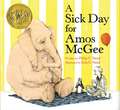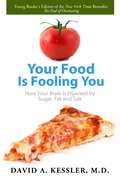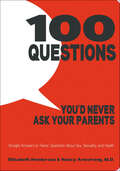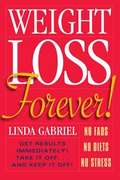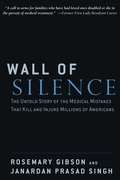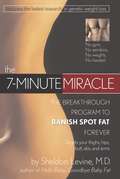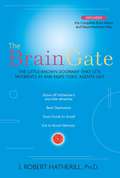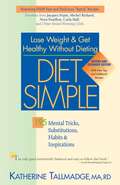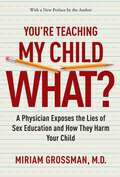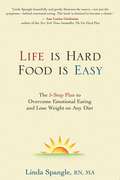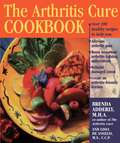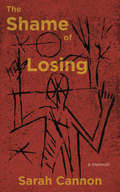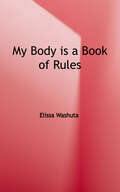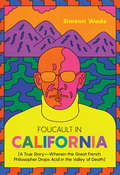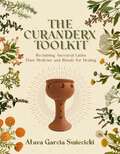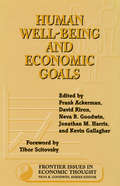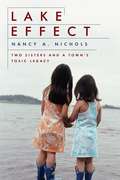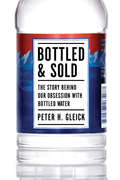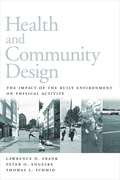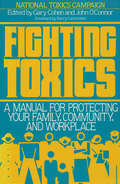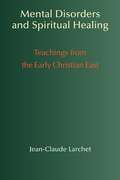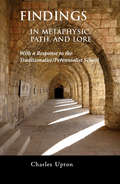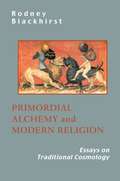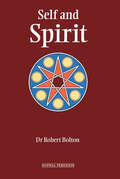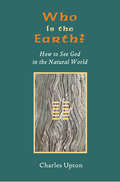- Table View
- List View
A Sick Day for Amos McGee
by Philip C. Stead Erin E. SteadTHE BEST SICK DAY EVER and the animals in the zoo feature in this striking picture book debut. Friends come in all sorts of shapes and sizes. In Amos McGee's case, all sorts of species, too! Every day he spends a little bit of time with each of his friends at the zoo, running races with the tortoise, keeping the shy penguin company, and even reading bedtime stories to the owl. But when Amos is too sick to make it to the zoo, his animal friends decide it's time they returned the favor A Sick Day for Amos McGee is a 2011 Bank Street - Best Children's Book of the Year and the winner of the 2011 Caldecott Medal. Images and image descriptions available.
Your Food is Fooling You: How Your Brain Is Hijacked by Sugar, Fat, and Salt
by David A. KesslerFormer commissioner of the US Food and Drug Administration David Kessler, M.D., argues forcefully that our brain chemistry is being hijacked by the food we eat: that by consuming stimulating combinations of sugar, fat, and salt, we're conditioning our bodies to crave more sugar, fat, and salt―and consigning ourselves to a vicious cycle of overeating.
100 Questions You'd Never Ask Your Parents: Straight Answers to Teens' Questions About Sex, Sexuality, and Health
by Elisabeth Henderson Nancy ArmstrongTeens have questions about sex. This simple manual answers their questions--honestly, simply, and reliably.What does an orgasm feel like?Does masturbating have any long-term negative effects?Does alcohol kill brain cells?Teens have questions about sex; it's a matter of who they ask and how reliable the answers are. Collected directly from teens and presented in a simple and accessible Q&A format, Elisabeth Henderson and Dr. Nancy Armstrong's 100 QUESTIONS YOU'D NEVER ASK YOUR PARENTS provides information about sex, drug, body, and mood in a way that's honest, nonjudgmental, and responsible.
Weight Loss Forever!: NO FADS. NO DIETS. NO STRESS. GET RESULTS IMMEDIATELY!
by Linda GabrielHow is this program different?What if I told you that it's as important to manage the thoughts you feel yourself as it is to manage the food you eat? What if your physical condition is simply a reflection of your inner world? Perhaps in the past you have managed to lose weight through diet and exercise alone. However if you didn't address the underlying subconscious thoughts that created the problem in the first place, the weight probably returned.As a hypnotherapist I have come to deeply respect the power of the subconscious mind. I believe the root cause of becoming overweight is usually mental, emotional and spiritual, rather than physical. When you change your mind, the body follows automatically. Then you lose weight easily, steadily, seemingly without effort.-Linda Gabriel
Wall of Silence: The Untold Story of the Medical Mistakes That Kill and Injure Millions of Americans
by Rosemary Gibson Janardan Prasad SinghMedical mistakes occur with alarming frequency in this country. Nightly newscasts and daily newspapers tell of botched surgeries, mistaken patient identities, careless overdoses, and neglected diagnoses. You may have dismissed these stories as unfortunate mistakes, misunderstandings, or just isolated incidents with the occasional bad doctor. <P><P>Wall of Silence reveals that these medical mistakes are not rare incidents with the occasional bad doctor. In fact, the real-life stories in this book show that medical mistakes are increasing in frequency-and worse, that the system is designed more to cover up these errors than prevent them.
The 7-Minute Miracle: The Breakthrough Program To Banish Spot Fat Forever
by Sheldon LevineWEIGHT LOSS FOR THE 21ST CENTURY No weights! No diets! No aerobics! No gym memberships! The 7-Minute Miracle is the genetically based program that lets you actually spot reduce fat in your most troublesome areas: your thighs, hips, buttocks, abs, and arms. Using the latest scientific discoveries about genetics and weight loss, this breakthrough plan focuses your body's natural weight-loss abilities like a laser-right on the spot that troubles you the most. In just 7 minutes a day you can melt away fat to expose and define your muscles underneath. The 7-Minute Miracle program has helped hundreds of patients lose inches, lose weight, and feel great doing it-in just 7 minutes a day! Now you can too!
The Brain Gate: The Little-Known Doorway That Lets Nutrients in and Keeps Toxic Agents Out
by J. Robert HatherillIn this groundbreaking book, Dr Hatherill, a leading toxicologist, brings to light the latest discoveries of how the brain works, and explains exactly what we can do to preserve the brain's vital functions. This new science looks closely at the blood-brain barrier--literally the gateway to the brain, which determines what enters our brain and what doesn't. <P><P>Dr Hatherill's research into toxic substances and nutritional elements shows that what gets into our brain affects emotions, intelligence, disease, and overall well-being far more than scientists ever believed possible. Stress, cancer-fighting drugs, common medications, even the elements in processed foods, all allow harmful toxins to cross over and enter our brain and cause disease. <P><P> The book includes a comprehensive 'Six-Step Brain Purification Program', the only brain detox and nutrition plan that jump-starts optimum brain health. You will find the Top 10 substances that threaten the health of your brain, and learn what foods you can use to fight off such debilitating diseases as Alzheimer's and Parkinson's disease.
Diet Simple: 195 Mental Tricks, Substitutions, Habits & Inspirations
by Katherine TallmadgeMatching Tips to PoundsThe secret to losing weight and keeping it off for good is simple. It's the small, easy changes you make in eating that have the most dramatic and lasting results. <P><P>Diet Simple is the only program that shows you exactly which changes to make and how much weight you can expect to lose. Learn how to replace fat-laden habits you'll never miss, make substitutions you'll relish, and retool your mind to view eating in a whole new way. All in a style that's fresh, entertaining, and fun. Here's just a taste of what you'll discover inside:How singing in the shower can help you lose 26 pounds.How visiting "Old MacDonald" can help your kids lose 10 pounds.How your alarm clock can help you lose 14 pounds.How "Batch" Recipes can help you lose 40 pounds.Plus lots more tips for the whole family!
You're Teaching My Child What?: A Physician Exposes the Lies of Sex Education and How They Harm Your Child
by Miriam GrossmanIf you think sex education is still about the birds and the bees, think again. And it's not about science either. In her shocking exposé, You're Teaching My Child What?, Dr. Miriam Grossman rips back the curtain on sex education today, exposing a sordid truth. Today's sex ed programs aren't based on science; they're based on liberal lies and politically correct propaganda that promote the illusion that children (yes, children) can be sexually free without risk. As a psychiatrist and expert on sexual education, Dr. Grossman cites example after example of schools and organizations whitewashing—or omitting altogether— crucial information that doesn't fit in with their "PC" agenda. Instead, sex educators only tell teens the "facts of life" that promote acceptance, sexual exploration, and experimentation. What sex educators call an education, scientists would call a scam: • Sex educators won't tell girls their bodies are biologically and chemically more susceptible to STDs; they will only say 3 million girls have a sexually transmitted infection • Educators say it's natural for children to "explore" their sexuality from a young age and only they can decide when it's right to have sex—the real truth is neurobiologists say teen brains are not developed to fully reason and weigh consequences, especially in "the heat of the moment" • Teens are told condoms, vaccines and yearly testing provide adequate protection, without being told that studies now show condoms are no match for herpes, HPV and gonorrhea In You're Teaching My Child What?, Dr. Grossman reveals biological truths that you won't find in today's classrooms. You're Teaching My Child What? is critical reading for parents with teens and instrumental in teaching children the truth about sex.
Life is Hard, Food is Easy: The 5-Step Plan to Overcome Emotional Eating and Lose Weight on Any Diet
by Linda SpangleLinda Spangle, founder and director of the highly successful WINNERS for Life wellness and weight-loss clinic, offers hope to those who want to take control over their eating habits and lose weight for good. Life Is Hard, Food Is Easy will completely change the way you think about food, giving you a powerful strategy for conquering your emotional eating habits and achieving lasting weight-loss success. With Spangle's approach, you can succeed on any diet. Without it, most diets are doomed to fail. Using specific guidelines, each step in Spangle's 5-step plan involved answering a question related to the connection between food and emotions.
The Arthritis Cure Cookbook
by Brenda AdderlyUnlock the secrets of a healthy, joint-preserving diet!A Step-by-Step Nutritional Guide to Completing the CureIn The Arthritis Cure Cookbook you'll learn simple ways to incorporate into your everyday meals the seven guidelines to a healthy, join-preserving diet including how to:Ease the symptoms of osteoarthritis with delicious and easy-to-make mealsBoost important arthritis-fighting antioxidants in the bloodstreamFocus on inflammation-reducing foodsReplace important nutrients depleted by prescription arthritis drugsMaximize your energy and rediscover the joy of cookingCreate an arthritis-friendly kitchen that minimizes the strain on your jointsWith a wide range of recipes for breakfast, lunch, appetizers, side dishes, salads, vegetarian meals, main dishes and more. The Arthritis Cure Cookbook is sure to delight almost any palate!So cook and eat your way to good health with The Arthritis Cure Cookbook! It will change your life!
The Shame of Losing: A Memoir
by Sarah Cannon&“A book about the brutal realities of a traumatic brain injury; but it is also about a young mother trying to save her own life. Honest, poetic.&” ―Ann Hedreen, author of Her Beautiful Brain On the morning before Halloween in 2007, Sarah receives a phone call from her husband&’s arborist colleague. Matt, her spouse of seven years and father of their two small children, has been severely injured by a falling tree branch while working in a neighborhood east of Seattle. Visions of their future go dark as she learns to care for the man she depended on for support. Faced with choices about how to behave through this unexpected journey, she takes as many steps back as she does forward and begins a rite of passage she never imagined. The Shame of Losing &“is an unforgettable story of a &‘full-time witness&’ to trauma and its aftershocks. With refreshing candor and a brilliant sense of humor, Sarah takes us through the maze of caring for a loved one who has suffered a traumatic brain injury and reckons deeply with what her own recovery should look like&” (Leigh Stein, author of Self Care). &“A major strength of this memoir is Cannon&’s passionate release of her voice, her shame.&” —Punctuate &“Sarah Cannon&’s memoir navigates trauma&’s juggernaut in a way so compelling the reader witnesses the opening catastrophe first-hand through the lens of her experience . . . With fierce unflinching grit she faces the unrelenting learning her struggle demands and emerges with discerning hard-won clarity. Her courage is palpable and inspires.&” —Joan Fiset, author of Namesake
My Body Is a Book of Rules
by Elissa Washuta"A candid, autobiographical scrapbook from a young woman navigating manic depression....A fever dream of darkly personal memories and musings from the shadowy corners of sexual violence and mental illness." <p><p>As Elissa Washuta makes the transition from college kid to independent adult, she finds herself overwhelmed by the calamities piling up in her brain. When her mood-stabilizing medications aren't threatening her life, they're shoving her from depression to mania and back in the space of an hour. Her crisis of American Indian identity bleeds into other areas of self-doubt; mental illness, sexual trauma, ethnic identity, and independence become intertwined. Sifting through the scraps of her past in seventeen formally inventive chapters, Washuta aligns the strictures of her Catholic school education with Cosmopolitan's mandates for womanhood, views memories through the distorting lens of Law & Order: Special Victims Unit, and contrasts her bipolar highs and lows with those of Britney Spears and Kurt Cobain. <p><p>Built on the bones of fundamental identity questions as contorted by a distressed brain, My Body Is a Book of Rules pulls no punches in its self-deprecating and ferocious look at human fallibility. This debut memoir from the independent publisher Red Hen Press isn't for the faint of heart. Washuta's honest and lyrical language as well as her subject matter—her struggles with bipolar disorder and coping with the effects of rape—will gut you, but it's the rawness of this work that makes it worth reading. Washuta's form, including revised psychiatrists' notes, annotated research papers on the use of the term "hooking up," summaries of prescription medications, and a Match.com profile, is inventive and invites the reader into the author's chaotic brain. The book perfectly articulates the difficulties navigating the path toward adulthood while coping with trauma and mental illness.
Foucault in California: [A True Story—Wherein the Great French Philosopher Drops Acid in the Valley of Death]
by Simeon WadeIn The Lives of Michel Foucault, David Macey quotes the iconic French philosopher as speaking “nostalgically…of 'an unforgettable evening on LSD, in carefully prepared doses, in the desert night, with delicious music, [and] nice people'”. This came to pass in 1975, when Foucault spent Memorial Day weekend in Southern California at the invitation of Simeon Wade-ostensibly to guest-lecture at the Claremont Graduate School where Wade was an assistant professor, but in truth to explore what he called the Valley of Death. Led by Wade and Wade's partner Michael Stoneman, Foucault experimented with psychotropic drugs for the first time; by morning he was crying and proclaiming that he knew Truth. Foucault in California is Wade's firsthand account of that long weekend. Felicitous and often humorous prose vaults readers headlong into the erudite and subversive circles of the Claremont intelligentsia: parties in Wade's bungalow, intensive dialogues between Foucault and his disciples at a Taoist utopia in the Angeles Forest (whose denizens call Foucault “Country Joe”); and, of course, the fabled synesthetic acid trip in Death Valley, set to the strains of Bach and Stockhausen. Part search for higher consciousness, part bacchanal, this book chronicles a young man's burgeoning friendship with one of the twentieth century's greatest thinkers.
The Curanderx Toolkit: Reclaiming Ancestral Latinx Plant Medicine and Rituals for Healing
by Atava Garcia SwiecickiA practical guide to understanding and using Mexican healing traditions in everyday life Arranging ofrendas. Brewing pericón into a healing tea. Releasing traumas through baños and limpias. Herbalist and curandera Atava Garcia Swiecicki spent decades gathering this traditional knowledge of curanderismo, Mexican folk healing, which had been marginalized as Chicanx and Latinx Americans assimilated to US culture. She teaches how to follow the path of the curandera, as she herself learned from apprenticing with Mexican curanderas, studying herbal texts, and listening to her ancestors. In this book readers will learn the Indigenous, African, and European roots of curanderismo. Atava also shares her personal journey as a healer and those of thirteen other inspirational curanderas serving their communities. She offers readers the tools to begin their own healing—for themselves, for their relationship with the earth, and for the people. The Curanderx Toolkit includes more than 25 profiles of native and adopted plants of Baja and Alta California and teaches you to grow, know, and love them. This book will help anyone who has lost connection with their ancestors begin to incorporate the herbal wisdom and holistic wellness of curanderismo into their lives. Take the power of ancient medicine into your own hands by learning simple herbal remedies and practicing rituals for kinship with the more-than-human world.
Human Well-Being and Economic Goals (Frontier Issues in Economic Thought #3)
by Kevin Gallagher Jonathan Harris Neva R. Goodwin David Kiron Frank Ackerman Kenneth ArrowWhat are the ends of economic activity? According to neoclassical theory, efficient interaction of the profit-maximizing "ideal producer" and the utility-maximizing "ideal consumer" will eventually lead to some sort of social optimum. But is that social optimum the same as human well-being? Human Well-Being and Economic Goals addresses that issue, considering such questions as: *Does the maximization of individual welfare really lead to social welfare? *How can we deal with questions of relative welfare and of equity? *How do we define, or at least understand, individual and social welfare? *And how can these things be measured, or even assessed? Human Well-Being and Economic Goals brings together more than 75 concise summaries of the most significant literature in the field that consider issues of present and future individual and social welfare, national development, consumption, and equity. Like its predecessors in the Frontier Issues in Economic Thought series, it takes a multidisciplinary approach to economic concerns, examining their sociological, philosophical, and psychological aspects and implications as well as their economic underpinnings. Human Well-Being and Economic Goals provides a powerful introduction to the current and historical writings that examine the concept of human well-being in ways that can help us to set goals for economic activity and judge its success. It is a valuable summary and overview for students, economists, and social scientists concerned with these issues.
Lake Effect: Two Sisters and a Town's Toxic Legacy
by Nancy A. NicholsOn her deathbed, Sue asked her sister for one thing: to write about the connection between the industrial pollution in their hometown and the rare cancer that was killing her. Fulfilling that promise has been Nancy Nichols' mission for more than a decade. Lake Effect is the story of her investigation. It reaches back to their childhood in Waukegan, Illinois, an industrial town on Lake Michigan once known for good factory jobs and great fishing. Now Waukegan is famous for its Superfund sites: as one resident put it, asbestos to the north, PCBs to the south. Drawing on her experience as a journalist, Nichols interviewed dozens of scientists, doctors, and environmentalists to determine if these pollutants could have played a role in her sister's death. While researching Sue's cancer, she discovered her own: a vicious though treatable form of pancreatic cancer. Doctors and even family urged her to forget causes and concentrate on cures, but Nichols knew that it was relentless questioning that had led to her diagnosis. And that it is questioning--by government as well as individuals--that could save other lives. Lake Effect challenges us to ask why. It is the fulfillment of a sister's promise. And it is a call to stop the pollution that is endangering the health of all our families.
Bottled and Sold: The Story Behind Our Obsession with Bottled Water
by Peter H. GleickPeter Gleick knows water. A world-renowned scientist and freshwater expert, Gleick is a MacArthur Foundation "genius," and according to the BBC, an environmental visionary. And he drinks from the tap. Why don't the rest of us? Bottled and Sold shows how water went from being a free natural resource to one of the most successful commercial products of the last one hundred years--and why we are poorer for it. It's a big story and water is big business. Every second of every day in the United States, a thousand people buy a plastic bottle of water, and every second of every day a thousand more throw one of those bottles away. That adds up to more than thirty billion bottles a year and tens of billions of dollars of sales. Are there legitimate reasons to buy all those bottles? With a scientist's eye and a natural storyteller's wit, Gleick investigates whether industry claims about the relative safety, convenience, and taste of bottled versus tap hold water. And he exposes the true reasons we've turned to the bottle, from fearmongering by business interests and our own vanity to the breakdown of public systems and global inequities. "Designer" H2O may be laughable, but the debate over commodifying water is deadly serious. It comes down to society's choices about human rights, the role of government and free markets, the importance of being "green," and fundamental values. Gleick gets to the heart of the bottled water craze, exploring what it means for us to bottle and sell our most basic necessity.
Health and Community Design: The Impact Of The Built Environment On Physical Activity
by Peter Engelke Lawrence Frank Thomas SchmidHealth and Community Design is a comprehensive examination of how the built environment encourages or discourages physical activity, drawing together insights from a range of research on the relationships between urban form and public health. It provides important information about the factors that influence decisions about physical activity and modes of travel, and about how land use patterns can be changed to help overcome barriers to physical activity. Chapters examine:* the historical relationship between health and urban form in the United States * why urban and suburban development should be designed to promote moderate types of physical activity * the divergent needs and requirements of different groups of people and the role of those needs in setting policy * how different settings make it easier or more difficult to incorporate walking and bicycling into everyday activitiesA concluding chapter reviews the arguments presented and sketches a research agenda for the future.
Fighting Toxics: A Manual for Protecting your Family, Community, and Workplace
by John O'Connor Barry Commoner Gary Cohen Barry National Toxics CampaignFighting Toxics is a step-by-step guide illustrating how to investigate the toxic hazards that may exist in your community, how to determine the risks they pose to your health, and how to launch an effective campaign to eliminate them.
Mental Disorders And Spiritual Healing: Teachings From The Early Christian East
by Jean-Claude LarchetThis work, the third panel of a triptych dedicated by the author to the notion of illness derived from the patristic and hagiographic texts of the Christian East from the first to the fourteenth centuries, makes an essential contribution to the history of mental illnesses and their therapies in a domain very little studied until now. Confronted by the numerous problems still posed today in understanding these illnesses, their treatment, and their relationship to those who are sick, he shows the importance offered for reflection and current practice by early Christian thought and experience. <p><p> After indicating how the Fathers understood the psyche and its relationship with body and spirit, the author gives a detailed analysis of the different causes they attribute to mental illness and the various treatments recommended. At the same time he shows how, relying on fundamental Christian values, they manifest a constant solicitude and respect for the sick, and how they are at pains to integrate them into community life and have them participate in their own healing, foreshadowing in this way the needs and aspirations of our own time. <p> The last part discloses the deep significance of one of the strangest and most fascinating forms of asceticism the Christian East has known: 'folly for the sake of Christ', a madness feigned with the goal of attaining a high degree of humility, but also a way well-suited, through a close experience of their condition, to help those who are often among, today as in the past, the most destitute.
Findings: In Metaphysic, Path, & Lore
by Charles UptonThe Traditionalist or Perennialist School of metaphysics, esoterism, and comparative religion, 'founded' by René Guénon and Ananda K. Coomaraswamy, and carried on by such figures as Frithjof Schuon, Titus Burckhardt, and Martin Lings, produced a body doctrine of rare depth and comprehension, effectively re-introducing to the modern and postmodern West the perennial wisdom of the human race. For the past twenty years, the author has immersed himself in these teachings, and made his own modest contribution to them. The three fundamental pillars of 'classical' Traditionalism/Perennialism are, (1) That God has sent more than one revelation to humanity, established more than one version of the Path by which the spiritual traveler may return to Him, each revelation being a providential branch of the great tree known as the Primordial Tradition; (2) That while certainly there is a Sophia Perennis, a unanimous and perennial wisdom given by God and transmitted from the dawn of humanity down to the present day, there cannot in our time be a Religio Perennis, a single universal doctrine and practice based on the Primordial Tradition; consequently the seeker must seek his vehicle among one of the living orthodox revealed traditions, not in some "revival" of a universal faith, or the fragments of it, from ages dead and gone; (3) Given that the present cycle of manifestation is rapidly approaching dissolution, the seeker's perennial duty to break identification with the system of collective egotism known as This World, and give his allegiance to God Alone, must now be seen in light of the fact that This World is about to end. Some presently associated with the Traditionalist/Perennialist School, however, no longer hold to "classical Traditionalism/Perennialism" as I have defined it. I have written this book partly to articulate some of the basic tenets of the first two generations of the Traditionalist School, so as to provide interested readers with a relatively stable point of reference that will hopefully allow them to see just how, and how much, that School has changed in the first years of the 21st century.
Primordial Alchemy & Modern Religion
by Rodney BlackhirstOf all the traditional sciences it is alchemy--based as it is in metallurgy--that is directly concerned with the coming of the industrial order. In alchemical terms, modern man lives in the Ferric Age and his state is best analogized to the properties of the metal iron: hard, cold, unbending, but quick to succumb to corrosion and rust. The great ancient wisdom traditions of the world all anticipated this present age, for it was already implicit in the technological and other changes that brought on the dawn of history. These ancient traditions--dismissed as childish superstitions by the scientist--contain ideas essential to the self-understanding that contemporary man so desperately needs. This is the central contention of the writings brought together in Primordial Alchemy & Modern Religion. Drawing upon many unexpected sources--especially Plato and the ancient Greeks--these wide-ranging, generous essays provide timely reiterations of ancient alchemical traditions and trace some pivotal themes that have continued in the theology and symbolism of the modern religions. This work restores some important keys for the recovery of a lost heritage of primordial wisdom, offering fresh perspectives on aspects of the Western and Islamic alchemical traditions in particular, and at the same time exploring the most distant roots of the modern impasse. There are many hidden treasures to be unearthed in this eclectic collection. From astrology and alchemy to horticulture and architecture, these essays demonstrate Rodney Blackhirst's concern with the reawakening of the scientia sacra. This collection challenges us to understand the symbolic language of these sacred sciences. With this understanding we commence the alchemical transformation that returns us to our primordial state. -- Dr. Tim Smith, editor, Eye of the Heart
Self And Spirit
by Robert BoltonWhat is the basis and purpose of esoteric religion, and what is the self? Self and Spirit answers these questions in depth and in a way true to the spirit of traditional wisdom. This book illuminates from a new angle the Non-Dualistic conceptions that have become influential through the work of many modern traditionalists, including René Guénon and Frithjof Schuon, whose influence is evident in Dr. Bolton's treatment of religion and tradition. Here, Gnostic ideas usually taken to support pantheistic religion are shown to be able to provide a foundation for belief in a personal God. Religion is not forced into a preconceived system, because no attempt is made to evaluate all religious doctrines by the standard of one doctrine. Instead, certain profound ideas common to many traditions are invoked, these ideas being of a kind that cannot be identified with any one confessional origin. This in turn sheds new light on the dividing-line between the esoteric and the exoteric, and allows these ideas to combine in ways that are natural and free. The key to this new departure is the true nature of the individual self, a subject largely ignored by Non-Dualist thought. Here it is given its full weight, however, and its impact on all other realities is made clear. The relation of the self to its world is also here connected significantly to the cosmic role of religion, illustrating how a conversion from worldly to spiritual priorities can have consequences far beyond the personal concerns of those involved. Throughout, Bolton's thinking is daring, yet true to traditional spirituality.
Who Is The Earth?: How To See God in the Natural World
by Charles UptonEver since the advent of "earth-based spiritualities" in our time, the call to realize the Divine Immanence, to see God in the forms of the natural world and the particular events of our lives, has become paramount. And yet, without a corresponding sense of the Divine Transcendence, we find ourselves drawn towards a kind of glamourized materialism, worshipping visible realities at the expense of the Invisible, taking as our deity a physical planet with a beginning and an end in time, instead of the living and eternal God, Who is before all beginnings and beyond all ends. This bias toward the Immanent as against the Transcendent (leading to the loss of both of them) has cast a shadow on the traditional religions, especially the Abrahamic ones: Judaism, Christianity and Islam. It has hidden from us the dimensions of those religions wherein it is explicitly stated that "the heavens declare the Glory of God and the earth shows forth His handiwork." In this book, the author attempts to right this balance by showing the place of the contemplation of the natural world, and a respect for the Earth, in all the traditional religions: Hinduism, Buddhism, Zoroastrianism, Taoism, Judaism, Christianity, Islam, and the Native American spiritualities. Even the Lakota understand that this "Mother Earth" is not the absolute Reality, that behind her stands "Grandmother Earth," and behind her, Wakan Tanka, the Great Mystery itself. To mistake the Earth for God is to place a burden upon her that she is unable to bear, to deplete her resources and ultimately jeopardize her survival. But if we can regain the ability to contemplate God as He is in Himself, then this living Earth, and the material universe around us, will take their proper place in this contemplative act. They will be revealed as God's icon, the ensemble of His placeless and eternal signs manifesting in space and time, appearing through the only medium capable of bringing God and His universe together into perfect union: the human form. Charles Upton is a serious thinker from whom I have learned much. His writing merits close attention. Huston Smith, author of The World's Religions, etc.
